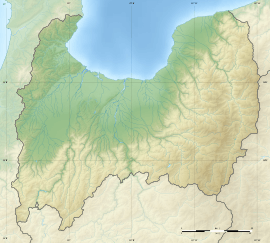Ōzuka-Senbōyama Sites
Ōzuka-Senbōyama Sites (王塚・千坊山遺跡群) is a group of archaeological sites located in what is now part of the city of Toyama in the Hokuriku region of Japan. The sites consist of the ruins of a settlement which existed from the late Jōmon period through Kofun period, a necropolis, and a keyhole-shaped kofun burial mound. These sites have been protected by the central government as a National Historic Site since 1952.[1]
王塚・千坊山遺跡群 | |
 Ōzuka-Senbōyama Sites  Ōzuka-Senbōyama Sites (Japan) | |
| Location | Toyama, Japan |
|---|---|
| Region | Hokuriku region |
| Coordinates | 36°39′38″N 137°07′01″E |
| Type | settlement, kofun |
| History | |
| Founded | 3rd and 4th century AD |
| Periods | Yayoi to Kofun period |
| Site notes | |
| Ownership | National Historic Site |
| Public access | Yes |
Outline
The site is located in central Toyama Prefecture, in an inland area some 12 kilometers from Toyama Bay on the Sea of Japan. A total of seven areas are covered under the National Historic Site designation:
1. The Senbōyama Site (千坊山遺跡) contains the ruins of a large Yayoi period settlement, of which 23 pit dwellings have been discovered. The dwellings were of two types: rectangular and circular. (45,654 square meters)
2. The Rokuji Kozuka Kofun (六治古塚墳墓) is a rectangular "corner protruding" burial tumulus from the late Yayoi period. This type of top was previously found only in the San'in region of Japan. It is located in the southern margin of river terrace near the Senbōyama Site and is believed to be contemporary with the settlement at that location. It measures 24.5 meters on each side, with a height of 5.1 meters, with the protruding portion 7.2 meters long and 10.6 meters wide. (2,490 square meters)
3. The Mukainozuka Kofun (向野塚墳墓) is a late Yayoi to early Kofun period keyhole-shaped kofun, located 110 meters northeast of the Rokuji Kozuka Kofun. Its design shows a transition phase between the rectangular tombs of the Yayoi period and the true keyhole-shaped tombs of the Kofun period, and is believed to have been built by the same people who settled the Senbōyama Site. The tomb has a 25.2 meter total length with the circular portion 16.5 meters in diameter and 1.7 meter high. (1,896 square meters)
4. The Tomisaki Kofungun (富崎墳墓群) is a cluster of three late Yayoi period rectangular "corner protruding" tombs located on the right bank of the Yamadagawa River on the northern margin of Tomisaki hill. Tombs 1 and 2 are 21.7 meters on a side, with a height of 3 meters, and Tomb 3 is slightly larger at 22 meters per side with a height of 3.9 meters. In each case, the protrusion has a length of 6 meters. (8,118 square meters)
5. The Tomisaki Chisato Kofungun (富崎千里古墳群) is a necropolis built in the early Kofun period, of which 17 kofun (one key-hole shaped, one dome-shaped, and 15 rectangular-shaped) have thus been discovered. It is located in the east margin of the Tomisaki Hills.(27,651 square meters)
6. The Ōzuka Kofun (王塚古墳) is one of the oldest and the fourth largest keyhole-shaped kofun in Toyama Prefecture. It has a total length of 58 meters. The front portion is 27 meters by 26 meters and 3.6 meters high, and the rear portion is 31 meters by 33 meters with a height of 7.6 meters. As the mound is considerably weathered, it may have originally been even larger. This kofun has never been excavated, so its interior structure and the presence of any grave goods is unknown. (2,452 square meters)
7. The Chokushizuka Kofun (勅使塚古墳) is a large tomb dating from the 3rd century. It measures 66 meters in total length, with a rear portion 31 meters x 24 meters with height of 3.5 meters and a front portion of 35 meters x 37 meters (narrowing to 11 meters in the waist) and a height of 9 meters. It was found to contain a rectangular burial chamber measuring 6.2 meters by 6.1 meters containing the remnants of a wooden sarcophagus and a large number of grave goods. (27,651 square meters)
References
- "王塚・千坊山遺跡群". Cultural Heritage Online (in Japanese). Agency for Cultural Affairs. Retrieved 25 December 2017.
External links
- http://www.city.toyama.toyama.jp/etc/maibun/center/topics/ohduka_senbouyama/ohduka_senbouyama.htm Toyama City official site] (in Japanese)